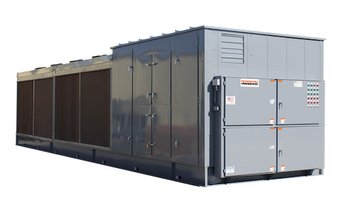Every year, the amount of electronic data that companies process and store grows exponentially. Data centers cannot economically increase the physical space available to keep pace with the growth, and are now challenged to provide more computer power in the same amount of space. The higher levels of microprocessing power demanded in the same physical footprint increases heat density, so owners need more efficient cooling systems that will keep up with the market without breaking the bank.
One technology receiving attention is adiabatic cooling, which uses up to 90 percent less water than other systems.
Balancing the environment and the bottom line
The demand for advanced computing power rises year after year, but the more powerful the system, the more heat it generates. As data centers grow, they place higher demands on cooling equipment. Packing as many kiloWatts and computer resources into a small space is key to reducing the cost and size of the facility. In doing this, data centers increase the power density of their systems, drawing more power, and generating more heat per unit area.
In addition to increasing power costs, owners are concerned about the environmental impacts of data centers, including their carbon footprint and their impact on local power plants and water usage. While power costs and water availability may vary from region to region, owners throughout the country are concerned about reducing operating expenditures and finding ways to transfer electronic data more efficiently, and with less electrical power and water than was used 10 years ago.
To make sure these powerful systems are in top shape and not overheating, cooling systems have to adapt and grow as well. To keep the business profitable, data centers must balance the benefits of advanced, powerful technology against the cost of running such computing systems. It has become clear that the industry can no longer go on the way it has for decades – constantly building larger and larger data centers as the need grows. Heat must be removed efficiently without adding significantly to the already high cost of running the data center.
High efficiency adiabatic cooling
All cooling equipment must reject heat to the atmosphere and most designers use either evaporative or air cooling. Evaporative coolers (cooling towers) are more energy efficient than air cooling systems, but they use high volumes of water and require costly maintenance and chemical treatment. A data center can easily use many millions of gallons of water each year.
Air cooled equipment operates well when ambient temperatures are cold, but it draws much more energy during hot seasons. This higher energy draw requires a larger and much more expensive infrastructure to support it. For example, backup generators must be sized for the highest possible draw, and are thus much larger than evaporative systems.
Recently, new technology has become available that uses a third option, adiabatic cooling, which incorporates both evaporative and air cooling into a single system. Adiabatic cooling systems use evaporation of water to pre-cool the ambient air to within a few degrees of the wet bulb, allowing much cooler and more efficient operation.
Unlike traditional cooling towers that constantly use water, the adiabatic system uses evaporative cooling only during the hottest part of the day and year. Air cooling only loses efficiency under unusually high ambient temperatures, so these are the only times evaporative cooling is truly necessary. During the rest of the time the system meets the facility’s cooling load without using any water, operating as a simple air-cooling system.
These systems can run dry for as much as 85 percent of the year in most climates, with up to 90 percent less annual water usage than other systems. When the ambient air is hot enough to require evaporative cooling, the system switches over, efficiently handling cooling needs for the whole year. When the ambient air is no longer hot, evaporation is no longer needed and the system can switch to dry air cooling without water. A system set up in this way allows data centers to efficiently cool their processors while using much less water than traditional cooling systems.
Evaporation is constrained within the adiabatic section, so the heat transfer coil remains completely dry, preventing unwanted scale buildup and reducing reliance on expensive chemical treatment systems.
Best of both worlds
Adiabatic systems consume far less energy than air cooled systems. These smaller kilowatt systems can in turn reduce the size of costly backup generators that support the cooling system. This reduction in infrastructure costs reduces the cost of building the facility and also reduces the power and utility bills. In addition, it also saves space, which can be used for the data centers’ electronics when there are footprint issues.
Adiabatic technology has been used for many years in the data center industry on the air side for air handlers, but has only just become available in mechanical equipment, with factory-built packaged units delivered ready for immediate use.The technology can be applied to fluid coolers, condensers, condensing units, and chillers.
Challenged to do more with less, data centers are seeking innovative ways to keep operating costs as low as possible – all while computer technologies may be changing as often as every three months. In a market demanding denser and more powerful electronics, data centers are pressed for cooling technology that can keep up with the times. New offerings in mechanical equipment, including packaged adiabatic cooling technology, helps data center owners meet the challenges posed by rising utility costs and environmental issues.
Adam Meyer is sales manager at Technical Systems, maker of Apex packaged cooling equipment


